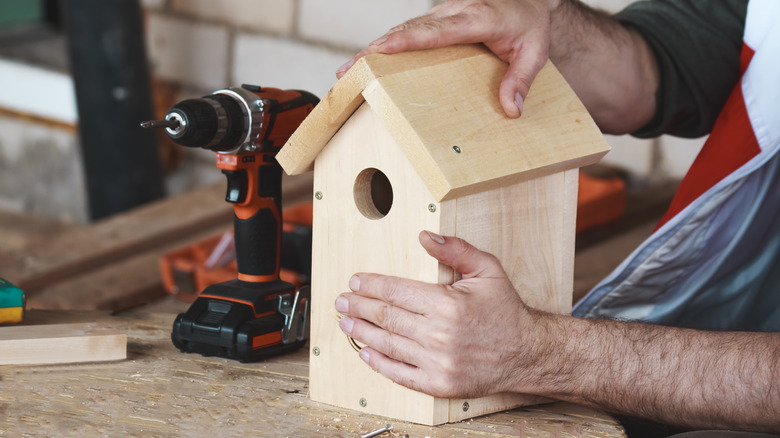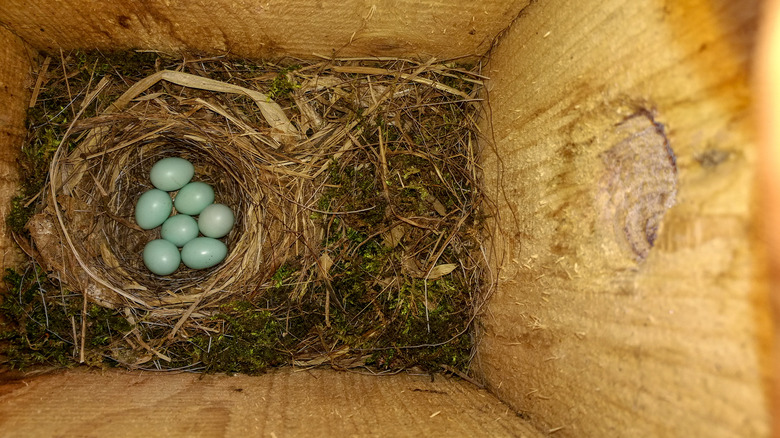How To DIY Your Own Birdhouse With A Camera
A birdhouse outfitted with a camera is an amazingly relaxing, fulfilling project. You can cozy up on the couch with your family to watch a nest full of hatchlings, or an episode of SpongeBob SquarePants you've watched with your kids a dozen times. The former stimulates a sense of wonder and appreciation for the natural world; the latter seems to stimulate a desire for sugary cereal products. So let's assume you're choosing the birdhouse path, and take a look at what you need to get your nest box broadcasting empire started.
A birdhouse with a reliable camera setup is a fairly small investment, and the basic build is pretty simple. In fact, the most complicated part of the whole thing is probably planning. You'll need to take into account a few important considerations: Is the location safe from predators like cats, snakes, raccoons, and even fire ants? How big does the box need to be to accommodate your camera? How will you get power to your camera? Are you building a box for a specific bird species? All of these things inform your early decisions. From there, you'll build the box, outfit it with the camera, and mount it. Once that is done, your interaction should be mostly with the feed from the camera, since it's a bad idea to clean, inspect, fix, or otherwise interfere with an active nest box.
Building the right birdhouse
There seem to be as many birdhouse plans online as there are birds. You can build nest boxes that aren't much more complicated than screwing a piece of pipe to a tree, you can construct an elaborate Victorian bird mansion, or go for something in between. Our favorite design is a one-board birdhouse as demonstrated by Bob Clagett on his "I Like to Make Stuff" YouTube channel. The tutorial is squarely aimed at kids, but the design is sound and simple enough for anyone to do, even with limited time and tools. But if you're interested in hosting a particular bird species, NestWatch's Right Bird, Right House tool will help you choose the right birdhouse design, and it flags species that are in decline for your particular region. Just remember to make sure your camera will work with your chosen design before you start building.
Here are some important tips for building the nest box: Use untreated wood and avoid paint, stains, and sealants that might be toxic. If you must seal a joint to protect your camera, use either waterproofing tape or a metal strip to cap the joint. Your design should have a sloped roof and drainage holes to shed water, ventilation holes for airflow, and the right entrance hole size for your birdhouse, which matters if you want to attract specific birds. Assemble it with galvanized screws, which you can remove later to clean your birdhouse the best way.
The best camera options for your birdhouse
You can start picking the right camera by narrowing down a few possibilities. You don't want anything battery-operated, since replacing them might cause your birds to abandon their nest box. Your birdhouse should be within wireless range (unless you're using a USB camera or a wired ethernet connection), and you will need to be able to supply power to it (unless you have a Power Over Ethernet camera). You'll still have a world of options to choose from — analog security cameras, USB webcams, IP network cameras, a Wi-Fi-enabled endoscope, and even an old phone converted into a webcam. One great option, if you're technically inclined, is a Raspberry Pi camera attached to a Raspberry Pi Zero W, a tiny computer with wireless functionality built in. There's even an infrared version that will help you see better in a dark nesting box. You can pick up this combo for about $45. You'll also need software on the viewing end, which can range from a web browser to an IP cam/CCTV viewer to stream broadcasting software like OBS Studio.
How you include the camera in your birdhouse build will depend on which camera you're using. Adjust your birdhouse plans as needed to add the camera to the ceiling of the box, or add a removable "attic" section to house the camera. Route power/ethernet/USB cables through small holes that won't admit rain. Test everything thoroughly before you mount the birdhouse to avoid disturbing the birds later.

